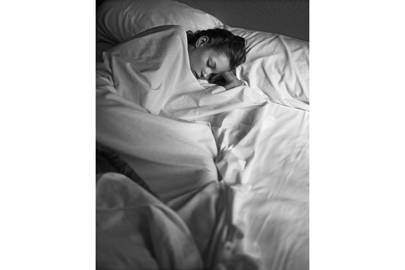The volume is an important piece of fashion history: it captures Moss – on the brink of supermodel stardom – enraptured by her first love and brimming with all the anticipation of a deer about to take a leap into the unknown or, in Moss’s case, the extraordinary. It was also a body of work that would cement Sorrenti‘s name into the masthead of fashion magazines and contracts with major brands, most notably the now iconic 1993 Calvin Klein Obsession campaign, starring Moss.
Sorrenti first met Moss on a photo shoot in London in 1991, but it wasn’t the high fashion scenario one might expect. “We were modelling together for the same commercial – I think it was something really cheesy like a hair product or Dentyne,” he recalls. “My heart just, like, stopped and I kind of clammed up. I was shy and didn’t have a lot to say. But she was very sweet and talkative.” By chance, the pair ran into each other at a party several weeks later and hung out all night, “walking into the early morning until we fell asleep on the grass in Hyde Park”. For the next two years, the pair were “inseparable”.

Moss was still living with her mother in Croydon, and the Neapolitan Sorrenti, who had grown up in New York from the age of 10 and relocated to London to pursue modelling, was staying with his agent. “We were really young, like kids, I was 19 and she was 17,” Sorrenti remembers. “We would crash out on people’s couches so we could be together, and I’m taking pictures all the time.”
“I was always very passionate about photography,” he continues, “studying and buying books on artists that were working in that medium and so on.” We turn to another page in the book where Moss’s unmistakable doe eyes, which have captivated the world via the lens of famous photographers for more than 25 years, peer out between the rails of a cast-iron gate. Two bare-chested boys with Mediterranean features (Sorrenti’s brother and his friend) stand at her side. “I call this my Paul Strand photo,” Sorrenti says with a smile, in reference to the American Modernist photographer who, along with Edward Weston and Dorothea Lange (also idols of Sorrenti’s) helped pioneer photography as an artform in the first half of the 20th century.

Moss was still living with her mother in Croydon, and the Neapolitan Sorrenti, who had grown up in New York from the age of 10 and relocated to London to pursue modelling, was staying with his agent. “We were really young, like kids, I was 19 and she was 17,” Sorrenti remembers. “We would crash out on people’s couches so we could be together, and I’m taking pictures all the time.”
“I was always very passionate about photography,” he continues, “studying and buying books on artists that were working in that medium and so on.” We turn to another page in the book where Moss’s unmistakable doe eyes, which have captivated the world via the lens of famous photographers for more than 25 years, peer out between the rails of a cast-iron gate. Two bare-chested boys with Mediterranean features (Sorrenti’s brother and his friend) stand at her side. “I call this my Paul Strand photo,” Sorrenti says with a smile, in reference to the American Modernist photographer who, along with Edward Weston and Dorothea Lange (also idols of Sorrenti’s) helped pioneer photography as an artform in the first half of the 20th century.
Throughout their relationship, Sorrenti says, “Kate, as a model, started to look at what she did differently because, I guess, she started to understand the passion behind photography. Slowly our knowledge of it grew together.” While the romance did not last (Moss has previously spoken about how his “obsession” with his work spilled over into their relationship), a close bond remained and the duo have continued to work and spend time together. “You know, it’s funny – a lot of people talk about Kate as my muse,” he says. “But really for us we were just boyfriend and girlfriend – and now friends – taking pictures.”

No comments:
Post a Comment